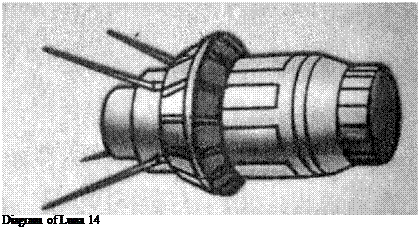FINALLY, COMMUNICATIONS TESTS
Russia flew a third series of moon probes. These have no direct American comparator. Called the Ye-6LS, little is known about them. Only an outline sketch of Luna 14 has been released (no photographs), showing that it was similar in design to the Ye-6LF. The purpose of the Ye-6LS series was to test out communications between moon orbit and the deep space tracking network, employing the systems to be used later by the manned lunar orbiter, the LOK. Two scientific instruments were also carried: one to measure charged solar particles, the other cosmic rays. One engineering experiment was also carried: more drive gears and lubricants, to test systems to be used on the upcoming series of lunar rovers.
This programme was sufficiently important for three Ye-6LS probes to be flown. The first was launched on 17th May 1967. It was intended that this spacecraft go into a high-Earth orbit reaching out to the full lunar distance, but away from the direction of the moon. In the event, the fourth stage cut out prematurely, leaving Cosmos 159
 |
in a highly irregular orbit, 260 km by 60,710 km. Although falling far short of that intended, the altitude probably was sufficient for a useful test of the LOK communication systems. The second Ye-6LS mission also failed. Block I cut off prematurely 524 sec into the mission on 7th February 1968 when the fuel inlet control jammed and it fell short of Earth orbit.
 |
The only fully successful mission, Luna 14, was flown out to the moon on 7th April 1968 and entered lunar orbit of 160 km by 870 km, 42°, 2 hr 40 min. Russian news agencies said almost nothing about it, except that it carried out studies of the stability of radio signals and the moon’s gravitational field. No one believed them at the time and assumed it was a failed photography mission. In reality, they were telling the truth. It was a test of communications (‘radio signals’) and a mission designed to measure the perturbation of lunar orbits by mascons. Although the discovery of mascons has always been assumed to be American, in fact it can be attributed to Luna 10. Mascons worried both sides equally, for they pulled orbiting spacecraft out of their predicted orbit by several kilometres. These distortions could make all the difference to where a spacecraft was targeted for landing and to the success of subsequent link-ups in lunar orbit. Apollo 11’s Eagle nearly ran out of fuel because its targeting was off-course and Neil Armstrong had to fly the lunar module far downrange to find a suitable area. Instruments were also carried to measure solar wind, cosmic rays and charged particles in lunar orbit, although their outcomes were not publicized. The Russians appear to have been well satisfied with Luna 14’s radio communications tests and mascon mapping, but, because it revealed much about their manned lunar ambitions, drew little attention to the mission.
Ye-6S, Ye-6LF, Ye-6LS series: scientific outcomes (with Zond 3)
Very weak magnetic field around the moon (distortion of the interplanetary magnetic field?). No lunar magnetic poles.
No differences in radiation emission levels between lunar lowlands and highlands.
Cosmic radiation at 5 particles/cm2/sec.
198 meteoroid impacts (Luna 10).
No gaseous atmosphere around moon found.
Finding of anomalous zones of mass concentrations below lunar surface disturbing the lunar orbit (mascons) (Luna 10); characterization of such zones (Luna 14).
Broad composition of lunar rocks (basaltic).
Selection of landing sites for manned and rover landings.
Infrared, ultraviolet scan of lunar surface (Zond 3).
Assessment of reflectivity of lunar surface and inferred density.










